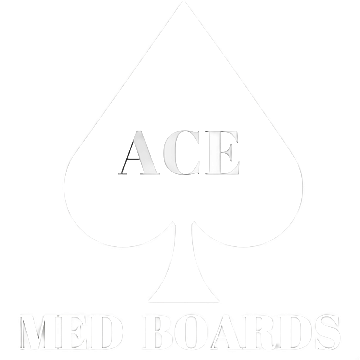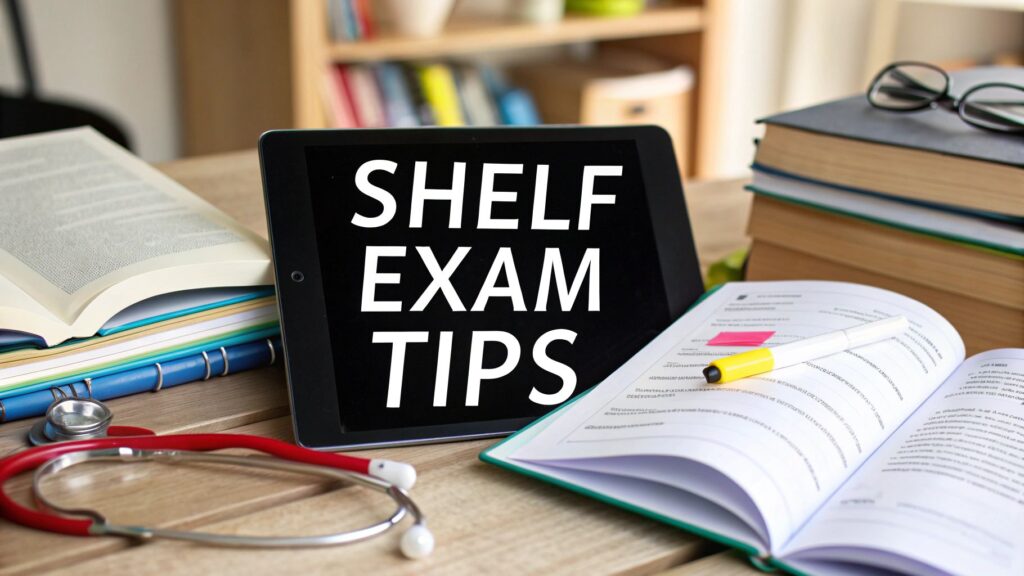Let's be honest: the secret to crushing your shelf exams isn't some magic bullet. It's about building a smart, sustainable study system that weaves directly into the chaos of your clerkship schedule.
You have to think of it as a cycle: pre-read, apply that knowledge on the wards, test yourself with practice questions, and then consolidate what you've learned. This turns every single day—even the most hectic ones—into a productive study session.
Building Your Framework for Shelf Exam Success
Before you even think about cracking open a textbook or logging into a question bank, you need a mental reset. Shelf exams aren't just mini-board exams. They're designed to test the clinical knowledge you should be picking up on your rotations.
This means that last-minute cramming is a recipe for disaster. Real success comes from continuous, integrated learning that starts the moment you set foot on the wards. The goal is to make studying feel like a natural extension of your clinical duties, not some separate, soul-crushing task you have to tackle at midnight.
Think of it this way: every patient you see is a study opportunity. When you encounter someone with new-onset atrial fibrillation, that’s your trigger. Later that day, you should be reviewing the diagnostic criteria, the latest treatment algorithms, and the most common complications. When you tie your studying directly to your clinical experiences, the information sticks. It becomes real and relevant, not just a list of facts on a page.
Shift From Passing to Mastering
Your goal shouldn't be to just scrape by with a pass. When you aim for mastery, you build a much stronger foundation of knowledge that will serve you on this exam, your future rotations, and—most importantly—your board exams.
This mindset shift is about pursuing deep learning over superficial memorization. It’s the difference between just knowing the side effects of a drug and truly understanding why those side effects happen.
The core philosophy is simple: Learn it once, learn it well. By focusing on understanding mechanisms and clinical reasoning from the start, you reduce the need for frantic re-learning in the final week before your exam.
This takes a proactive approach. Don't just passively wait for your attending to teach you something. Actively seek out information based on the patients you’re seeing. This creates a powerful feedback loop where your time on the wards reinforces what you read, and what you read makes you a sharper, more effective student doctor.
The Cycle of Integrated Learning
A truly effective study system for shelf exams is built on a simple, repeatable cycle. This process ensures you're covering the high-yield information efficiently without burning out.
- Pre-Reading: Before a new week or rotation, spend a little time skimming the core topics. This isn't about deep, exhaustive reading. It's about building a mental scaffold. That way, when you see a patient with a specific condition, you already have some context to hang the details on.
- Clinical Application: This is where the real learning happens. Actively connect what you see on the wards to what you've pre-read. Ask smart questions, present your patients with confidence, and always be thinking through differential diagnoses.
- Question-Based Review: Use a top-tier question bank like UWorld or Amboss to hammer home the concepts. Doing practice questions is the best way to solidify knowledge and uncover your weak spots in a low-stakes setting.
- Knowledge Consolidation: This step is critical. Spend time reviewing the explanations for questions you got wrong and the ones you got right. Make flashcards or quick notes for any concepts that just aren't sticking.
This infographic gives you a great visual for how to get your plan off the ground.
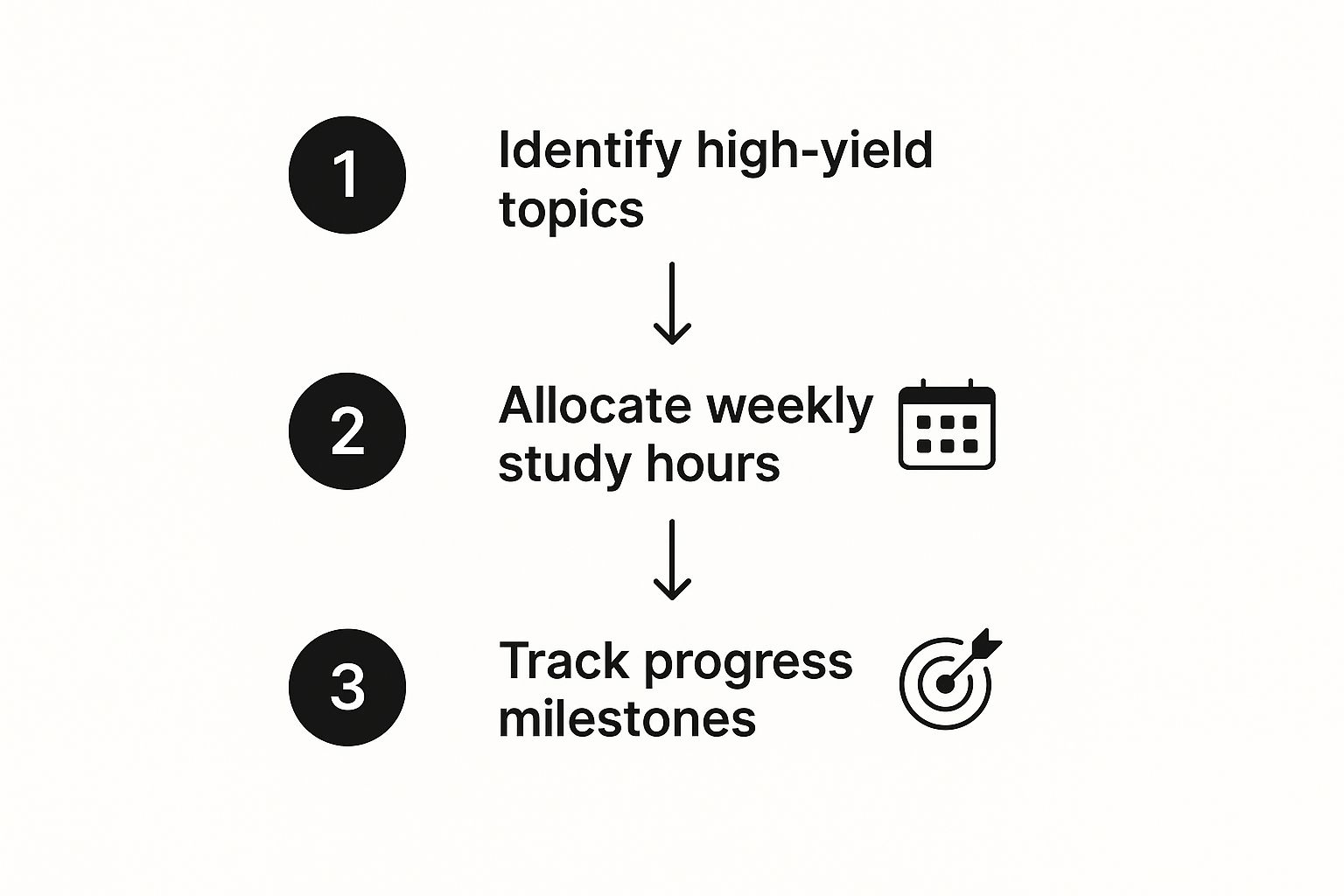
As the graphic shows, success starts with strategic planning before you dive into the material. While this approach is key for shelf exams, its effectiveness is proven on a larger scale. Global data on medical licensing exams consistently shows that a rigorous, multi-faceted approach combining clinical work with tons of practice questions is what drives top scores. If you're curious, you can explore more about these performance trends to see what separates the highest performers.
To help you organize these ideas, let's break down the core components of a winning study strategy.
The Pillars of an Effective Shelf Study Strategy
This table summarizes the foundational elements of a solid study plan, outlining what each component involves, why it's so important, and how you can put it into practice starting today.
| Strategy Component | Why It Matters | How to Implement |
|---|---|---|
| Integrated Learning | Connects book knowledge to real patient care, making information more memorable and relevant. | Use patient cases from your rotation as daily study prompts. Review conditions you see on the wards the same day. |
| Mastery Mindset | Focuses on deep understanding over rote memorization, building a stronger foundation for boards. | Instead of just learning facts, ask "why?" Focus on pathophysiology and mechanisms to reason through questions. |
| QBank-Centered Review | Actively tests knowledge, reveals weak areas, and familiarizes you with the exam format. | Dedicate daily time to a question bank like UWorld or Amboss. Prioritize reviewing explanations thoroughly. |
| Systematic Consolidation | Prevents knowledge decay by reinforcing difficult concepts and creating long-term memory. | Create targeted flashcards (Anki is great for this) or a "wrong answers" journal for concepts you miss. |
By building your study habits around these four pillars, you create a system that's not just effective for passing an exam but for becoming a knowledgeable and competent physician. This isn't about finding more hours in the day; it's about making the hours you have count.
Assembling Your High-Yield Resource Toolkit
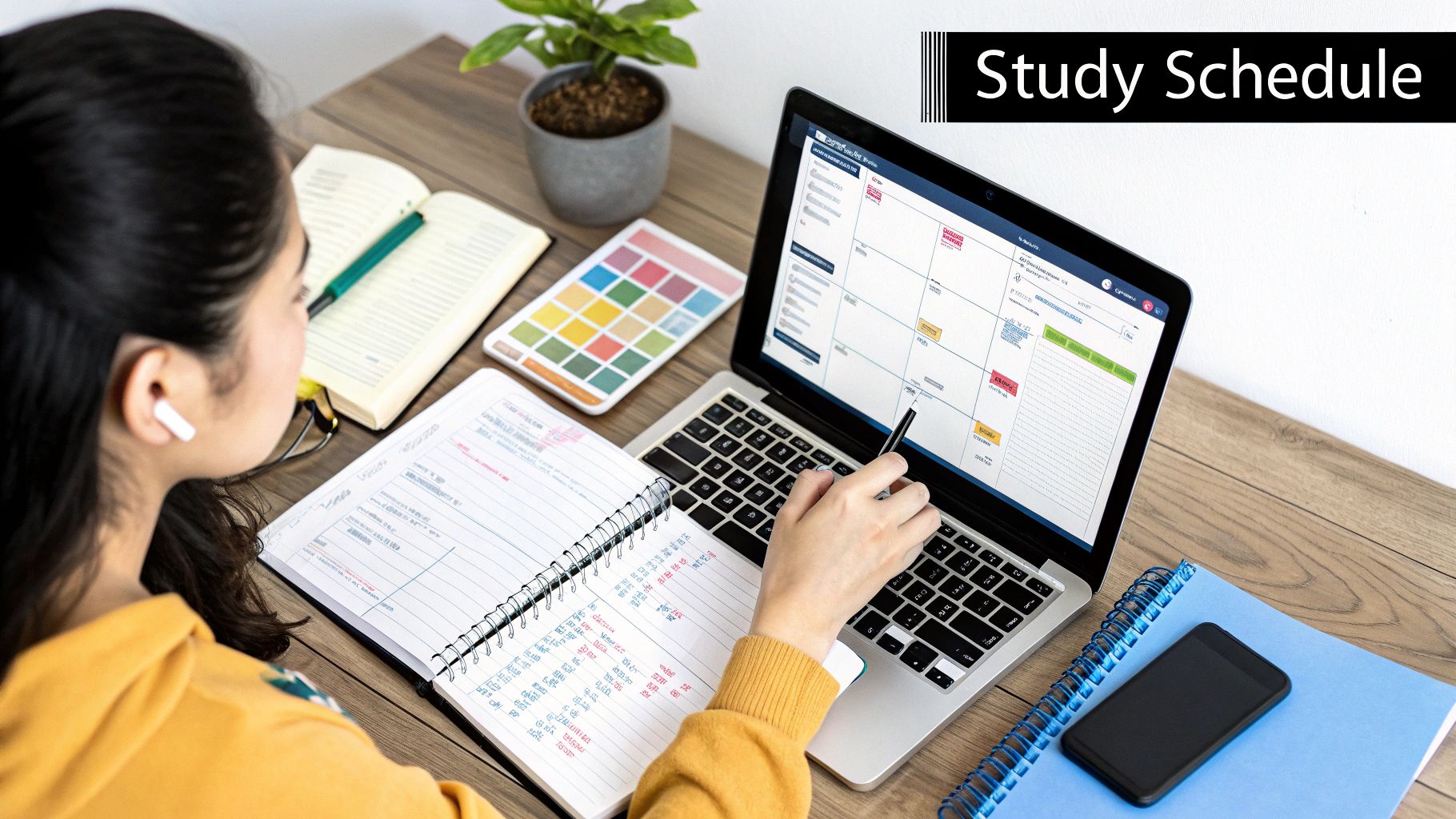
When you're figuring out how to study for shelf exams, the sheer number of resources can feel more paralyzing than helpful. Let’s be real: your most limited asset isn't money—it's time. The secret isn't to buy everything, but to avoid "resource overload" by building a lean, powerful toolkit that hammers high-yield information and forces active learning.
Instead of subscribing to a dozen different platforms, the students who crush their shelves almost always build their strategy around a core trinity of resources. This simple approach ensures you cover all your bases without drowning in conflicting information or redundant content.
The Holy Trinity of Shelf Prep
Think of your study resources as a three-legged stool. Each leg provides a different kind of support, and together they create a stable foundation for your knowledge. This core set should always include a question bank, a foundational content source, and a supplemental tool for targeted review.
Here’s the breakdown:
A Primary Question Bank (QBank): This is absolutely non-negotiable. Platforms like UWorld are the gold standard for a reason—they meticulously mimic the style, length, and difficulty of the actual NBME shelf exams. Doing questions is the single most effective way to test your knowledge, pinpoint your weaknesses, and actually learn the material.
A Foundational Content Source: You need a reliable place to learn the core material in the first place. This could be a video series like OnlineMedEd (OME), which gives you fantastic high-level overviews, or a classic textbook if that's more your style. This resource builds the framework; the QBank then fills in the critical details.
A Supplemental Review Tool: This is your secret weapon for shoring up weak points. Anki is perfect for drilling those discrete facts, drug names, or diagnostic criteria you consistently miss. Other tools like Amboss can serve a dual purpose as both a QBank and a clinical reference library, making it brilliant for quick lookups on the wards.
By sticking to this framework, you create a powerful, closed-loop system. You learn from your foundational resource, apply and test that knowledge with your QBank, and then use a tool like Anki to reinforce whatever doesn't stick.
Choosing and Using Your Resources Wisely
Just having these tools isn't enough; you have to use them effectively. The reality is, your strategy will—and should—change depending on the rotation you're on.
For example, on a fast-paced Surgery rotation, your days are spent in the OR and study time comes in short, fragmented bursts. Here, you might rely heavily on the Amboss mobile app to knock out 5-10 questions between cases. In the evening, a quick OnlineMedEd video can efficiently summarize the day's high-yield topics, like post-op fever or wound healing.
Contrast that with a Psychiatry rotation, which often has more predictable hours and less procedural time. You'll likely have more bandwidth for dedicated UWorld blocks and for creating detailed Anki cards to nail down DSM-5 criteria and psychopharmacology.
Key Takeaway: The best resource is the one you actually use. Don't feel pressured to use a tool just because it's popular. If you're a visual learner, a video series is far better than a dense textbook. If you're constantly on the move, a great mobile app is critical.
This active, question-first approach is the essence of effective test prep. It forces your brain to retrieve information, a process that builds far stronger neural connections than passively reading ever could. You can take a deeper dive into this evidence-based study method by exploring the power of active recall for medical students and how to integrate it into your daily routine.
A Common Pitfall to Avoid
The biggest mistake I see students make is accumulating too many resources. Buying access to UWorld, Amboss, Kaplan, and BoardVitals all at once just creates chaos. You'll end up doing a few hundred questions from each and mastering absolutely none of them.
Instead, commit to one primary QBank and make it your goal to complete at least one full pass of its questions for that specialty. This is the only way to ensure you've seen the full spectrum of high-yield topics tested on that particular shelf exam. Only after you've finished your primary QBank should you even consider using a second one for extra practice on your weak areas.
This disciplined approach is a cornerstone of how to study for shelf exams without burning out.
Designing a Realistic Clerkship Study Schedule
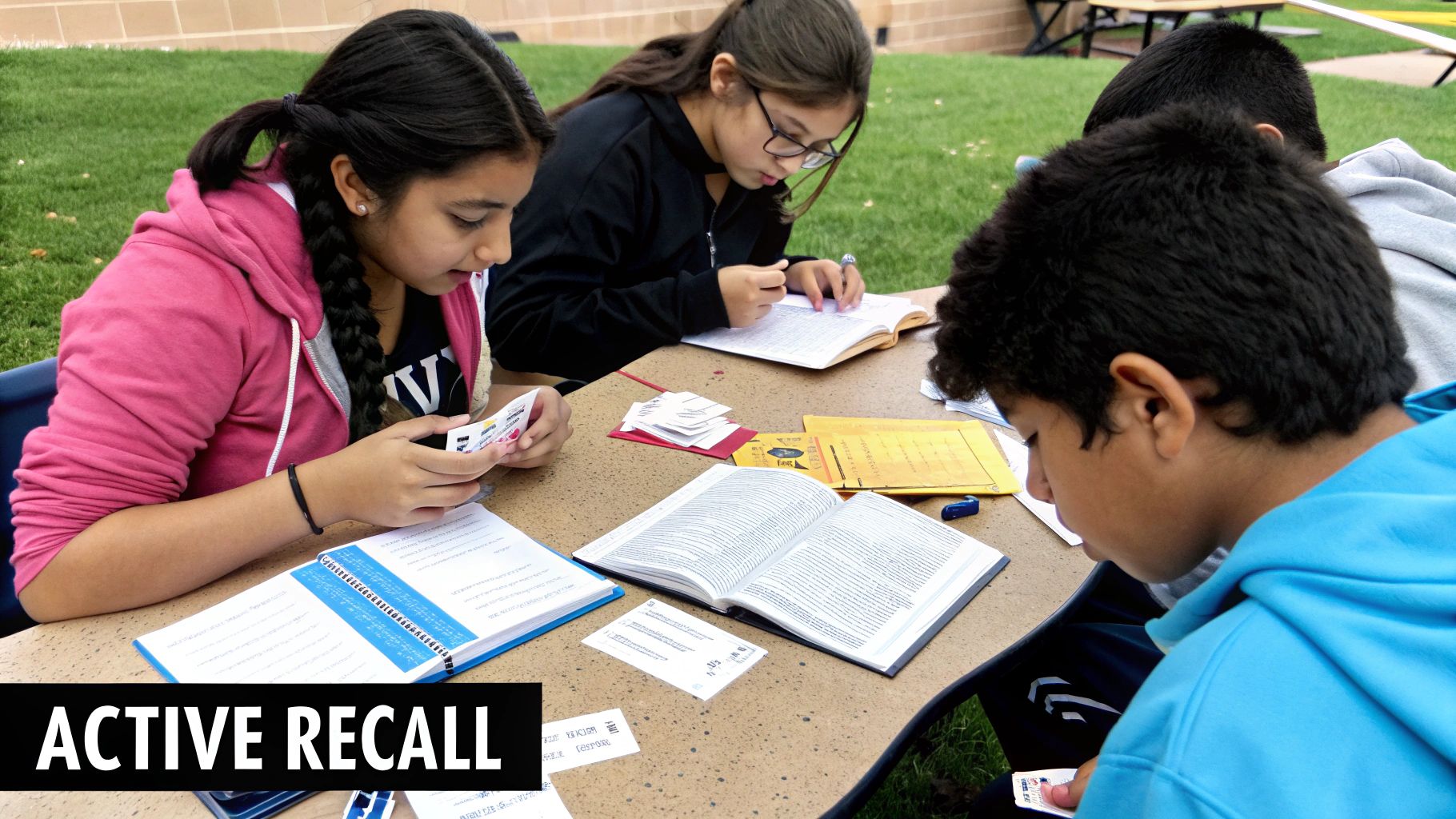
Even the best study resources are useless without a solid plan to actually use them. When it comes to shelf exams, your schedule is the engine that drives all your progress. A rigid, idealistic plan will completely fall apart by the first Tuesday; the real secret is building a flexible and realistic schedule that can bend without breaking.
Let's be honest, generic templates don't work here. What's your plan for that brutal 80-hour work week on your surgery rotation? Or when you're completely disoriented during your first week of night float? Your study schedule has to be built for the chaotic, unpredictable reality of clinical rotations.
Building a Flexible Weekly Template
First, map out your non-negotiables for the week—your clinic hours, on-call days, and any mandatory lectures. With those cornerstones in place, you can start identifying the hidden pockets of study time. These probably won't be clean two-hour blocks, but rather the small, underutilized moments you can reclaim.
- Pre-Rounds Power-Up: Can you get up just 30 minutes earlier to do 10-15 quick questions related to a patient's condition? This makes the information stick.
- Downtime Gold: That 20-minute gap between surgeries or the lull before afternoon patients arrive is prime real estate for knocking out some Anki cards on your phone.
- Commute Classroom: If you use public transit, that time is perfect for an episode of a high-yield podcast or a quick review video.
The goal is consistency, not cramming. Aiming for 60-90 minutes of focused study sprinkled throughout the day is far more sustainable than trying to force a four-hour session after an exhausting shift. Once you have a schedule, sticking to it requires focus. It’s worth exploring some practical tips for focus and productivity to make every minute count, especially when you’re tired.
The Two-Pass QBank Method
One of the most powerful strategies you can build your schedule around is completing two full passes of your main question bank, like UWorld. This method systematically builds your knowledge base and then ruthlessly reinforces it before test day.
Pass One: The Learning Phase
Think of your first pass as a learning tool, not an assessment. For the first few weeks of a clerkship, do all your questions in tutor mode. This lets you see the explanation immediately, which is absolutely critical for building that foundational understanding of new concepts. Don't stress about your percentage here. Your only job is to absorb the incredible amount of information packed into those explanations.
Pass Two: The Review and Assess Phase
In the final 1-2 weeks before the exam, it's time to switch gears. Your second pass should focus only on questions you got incorrect or marked for review. This time, do them in timed, random mode to mimic the real exam environment. This targeted approach shores up your weaknesses and builds the mental stamina you need for test day.
"My biggest scheduling hack was giving myself one protected 'catch-up' evening per week. If a surprise late case torpedoed my Tuesday plan, I knew I had a designated block on Thursday to get back on track. It prevented the snowball effect of falling behind."
— Former M3, now PGY-2
A simple schedule can provide the structure you need to integrate these study methods without feeling overwhelmed. It’s all about creating a rhythm that works with your clinical duties.
Here’s a look at how you could structure a typical week.
Sample Weekly Study Schedule for a Busy Clerkship
| Day | Morning (Pre-Rounds) | During Downtime | Evening |
|---|---|---|---|
| Monday | 15-20 targeted Q's on a patient's diagnosis | Anki review on phone | 40 Q's (Tutor Mode) + Review |
| Tuesday | Review yesterday's incorrects | Listen to a relevant podcast | 40 Q's (Tutor Mode) + Review |
| Wednesday | Quick Anki session | Review notes from morning report | 40 Q's (Tutor Mode) + Review |
| Thursday | 15-20 Q's related to clinic topic | Anki review on phone | Catch-up / Flex Time |
| Friday | Review a high-yield video | Read UpToDate on complex cases | Lighter review or social time |
| Saturday | Sleep in! | N/A | 1-2 hours of focused review or practice Q's |
| Sunday | Light Anki | Plan schedule for the upcoming week | Relax and recharge |
This table is just a template, of course. The key takeaway is to build a routine that prioritizes short, consistent efforts and includes built-in flexibility for the days when things inevitably go off the rails.
Adapting to Tough Rotations
Let's be real: your study plan needs to be adaptable. During a grueling rotation like trauma surgery or a disorienting month of night float, your main goal is simply to survive. High-yield, bite-sized activities are your best friend.
On the hardest days, just reading up on your own patients is studying. If you manage to learn one new, clinically relevant thing from each patient you see, you are absolutely still moving forward. The trick is to forgive yourself for not sticking to the plan perfectly and to have a system that lets you jump right back in the next day without guilt. That resilience is the hallmark of a schedule truly built for success.
Mastering Strategies for Each Core Shelf Exam
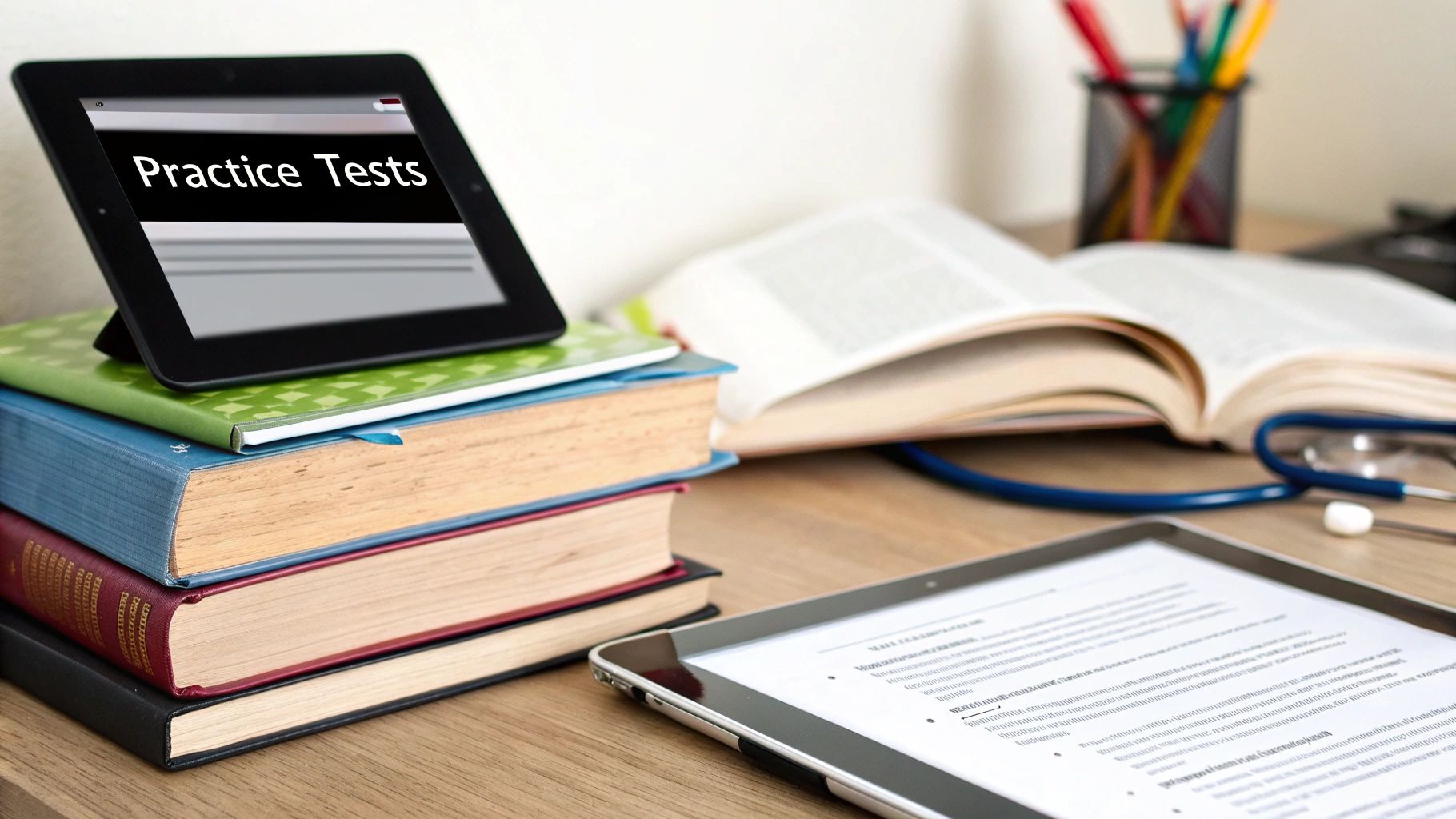
One of the biggest mistakes I see students make is treating every shelf exam the same. If you think the study plan that worked for Psychiatry will fly for the Surgery shelf, you're setting yourself up for a nasty surprise.
Each clerkship exam has its own unique personality. They test different skills, emphasize different knowledge areas, and even have a different "feel" to their questions. You have to adapt. Creating a tailored strategy for each rotation isn't just a good idea—it's the only way to consistently honor your shelves.
When you understand these nuances, you can stop wasting precious time and focus your energy on what actually gets you points. For one exam, that might mean locking down lab interpretations. For another, it's all about memorizing complex management algorithms.
Internal Medicine: The Test of Clinical Reasoning
There's a reason the IM shelf has a reputation for being the toughest—the sheer volume of content is staggering. But this exam is less about reciting obscure facts and more about testing your ability to think like a doctor. Can you build a solid differential, make sense of conflicting data, and confidently choose the "next best step"?
Forget rote memorization. Your study plan has to be built around understanding pathophysiology and management algorithms. Don't just learn the criteria for lupus; you need to understand why those symptoms happen in the first place.
- Key Focus: Diagnostic algorithms and management flowcharts.
- Question Style: Get ready for long, multi-step clinical vignettes. You'll need to synthesize info from the history, physical, labs, and imaging to arrive at the answer.
- High-Yield Tip: Cardiology, pulmonology, and gastroenterology are the heavy hitters. Give these systems extra attention, as they consistently make up a huge chunk of the exam.
Surgery: Recognizing Patterns and Complications
The Surgery shelf isn't really about the technical steps of an operation. It's about recognizing classic presentations of surgical diseases and, most importantly, managing post-op complications. Pre-operative risk assessment and post-operative care are where the points are.
Yes, anatomy is a big deal, but only in a clinical context. You don't need to know the blood supply to the colon for an anatomy bee. You need to know it because it's the key to understanding ischemic colitis in a post-op patient.
Expert Insight: The students who crush the Surgery shelf are the ones who can instantly tell the difference between a post-op fever on day 1 versus day 5. They spot a subtle wound dehiscence from a mile away. It's all about pattern recognition.
Pediatrics: Knowing Your Milestones and Bugs
The Peds shelf is a different beast altogether. It covers a massive range, from newborn metabolic screens all the way to adolescent behavioral issues. Two areas trip students up time and time again: developmental milestones and infectious diseases.
You absolutely must have a rock-solid grasp of what a child should be doing at 2, 4, 6, 9, and 12 months, and beyond. Likewise, knowing the most common pathogens by age group—like the different causes of meningitis in a neonate versus a toddler—is pure, high-yield gold.
OB/GYN and Psychiatry: Exams of Nuance
The Obstetrics and Gynecology shelf is incredibly protocol-heavy. Success comes down to knowing the precise guidelines for things like prenatal screening, labor management, and GYN cancer screening. The questions are often driven by established protocols, making resources like the ACOG guidelines essential.
Psychiatry, on the other hand, is a test of diagnostic criteria and pharmacology. Your score will hinge on your fluency with the DSM-5. You have to be able to tell the difference between similar-looking personality disorders or mood disorders and know the first-line meds for each.
Changing your study approach for each exam's specific style is a globally proven key to success. Just look at the data from the Foreign Medical Graduate Examination (FMGE). Students from countries like Australia, where curricula align closely with exam standards, hit a 100% pass rate. Meanwhile, those from nations with less-aligned systems can see rates as low as 11-12%. That massive gap proves one thing: success is tied to how well your preparation matches the exam's demands. You can dig into the full analysis of these global pass rate findings to see just how critical this alignment is.
Ultimately, honoring your shelves requires a flexible mindset. The core principles of using a QBank and learning from your clinical rotations are universal. But the specific content you hammer home has to change with each new rotation. For more general advice that works across all exams, be sure to check out our guide on essential medical exam study tips.
Advanced Techniques for Acing Exam Day
All your hard work building a solid knowledge base comes down to one thing: how you perform on exam day. Knowing the material cold is only half the battle. The other half is having the right strategy to execute when you're under pressure.
This isn't about cramming more medical facts. It's about learning how to take the test itself. When you’re staring down a long clinical vignette with five plausible-sounding answers, your approach matters just as much as your knowledge. Mastering a few key techniques can make a massive difference in your final score.
Deconstructing the Clinical Vignette
The NBME loves to bury the important details in a sea of fluff. The first step is to avoid getting bogged down. Many students find it incredibly helpful to read the last sentence of the question stem first. This immediately tells you what you're being asked—is it the diagnosis, the next best step, or the underlying mechanism?
Once you know what they're looking for, you can scan the vignette with purpose. You're no longer a passive reader; you're an active data collector, hunting for the specific clues needed to solve the puzzle.
As you read, mentally highlight the essentials:
- Patient Demographics: Age, sex, and relevant background are often critical clues.
- Chief Complaint & Duration: Is this an acute emergency or a chronic issue?
- Key Positive & Negative Findings: Note the presence of classic symptoms and, just as importantly, the absence of expected ones.
- Vital Signs & Lab Values: Pay close attention to anything that's even slightly outside the normal range.
This structured approach helps you filter out the noise and zero in on what the question is truly asking. The analytical thinking required here is very similar to what you'll need for the boards. If you want a deeper dive, our guide on how to study for USMLE Step 1 has some fantastic strategies that apply directly to shelf exams.
Managing Time and Test Anxiety
Shelf exams are a marathon, not a sprint. Your time management has to be on point if you want to avoid a frantic rush at the end. A good rule of thumb is to give yourself roughly 90 seconds per question. If you find yourself spending more than two minutes on a single question, it's time to make your best educated guess, mark it, and move on.
Key Takeaway: Do not let one tough question derail your entire exam. Your goal is to bank as many points as possible from the easy and medium-difficulty questions. You can always come back to the monsters if you have time left.
We've all been there. You hit a question and your mind goes completely blank. Test anxiety is real, but you can manage it. Take a deep breath. Start by systematically eliminating the answers you know are wrong. More often than not, you can narrow it down to just two choices, which dramatically improves your odds of guessing correctly. This proactive strategy helps you regain a sense of control and keeps your confidence from taking a nosedive.
What to Do When You Truly Don’t Know
It’s going to happen. You’ll get a question on some obscure topic you've never even heard of. Panicking is not an option.
Instead, trust your clinical intuition and look for patterns. The NBME often plants "buzzwords" or classic associations in the question stem. Does one answer choice bring to mind a common drug side effect or a condition frequently linked to the patient's demographic?
If all else fails, go with the answer that represents the most common or classic presentation of a disease. Avoid picking the rare "zebra" diagnosis unless the vignette provides overwhelming evidence pointing you in that direction. This kind of strategic guessing gives you the best statistical shot at landing on the correct answer.
The importance of test-taking skill, not just raw knowledge, is seen in medical licensing exams worldwide. For instance, data from Korea's exam shows a huge drop-off in pass rates between their written exam and their final practical exam. This highlights that success in high-stakes medical testing requires both a deep understanding of the material and the ability to apply it with a cool head. You can read more about these telling exam statistics and see for yourself how they underscore the need for composed, strategic test-taking.
Acing exam day is a skill, and just like any other, you can build it with practice.
Answering Your Top Shelf Exam Questions
Even with the best-laid plans, a few nagging questions always seem to surface once you're deep in the trenches of a clerkship. Getting straight answers to these common worries can be the difference between feeling confident and feeling overwhelmed. Let's clear up some of the most frequent questions medical students have about how to ace their shelf exams.
How Many Practice Questions Should I Really Be Doing Every Day?
There's no single magic number here, but a great target that's both productive and sustainable is 40-80 questions per day. This usually means knocking out one or two 40-question blocks from your main QBank.
On lighter clinical days or over the weekend, pushing for two blocks (80 questions) is a fantastic way to get ahead. But on those brutal days when you're just trying to survive? Getting just one block done is still a huge win. Consistency always beats cramming.
The most important part of doing questions isn't the volume—it's the review. It is far better to do 40 questions and spend an hour dissecting every single explanation (yes, even the ones you got right) than to blaze through 100 questions with a superficial review.
This is where the real learning happens. That deep dive into the explanations is what helps you spot patterns, truly grasp the "why," and stop making the same mistakes when it counts.
Should I Do Questions By Subject Or In Random Mode?
The answer is both—it just depends on when you do them. Your approach should change as you move through each rotation.
Early in the Rotation (First 2-3 Weeks)
- Stick to Subject-Specific Mode: When you’re on your cardiology rotation in Internal Medicine, it makes sense to hammer cardiology questions. This builds a solid foundation and directly connects what you're seeing on the wards to what you're studying, making the information stick.
Later in the Rotation (Final 2-3 Weeks)
- Switch to Random, Timed Mode: This part is non-negotiable. The real shelf exam is a random mix of everything. You have to train your brain to jump from a GI question to an endocrinology question without missing a beat. Simulating that test-day scramble with random blocks is the only way to get a real feel for your readiness.
Making this shift from focused learning to test simulation is a cornerstone of any effective shelf exam study plan.
What Should My Last Week of Studying Look Like?
The final week is for consolidation and confidence, not cramming. The goal is to sharpen what you already know and get your head in the game for test day.
Here’s a simple game plan for that last critical week:
- Hit Your Incorrects: The highest-yield thing you can do is go back and re-do all of your incorrect and marked questions in your QBank. These are your known weak spots.
- Review High-Yield Notes: Do a quick pass over your notes, Anki cards, or any summaries you made for topics that gave you trouble. Keep it light.
- Take One Last Practice Test: About 3-4 days out from your exam, take a final NBME practice exam. Use it as a final check on your timing and a confidence booster.
- Put the Books Away: This is vital. By the early afternoon on the day before your exam, you need to stop. Your brain needs time to rest. Last-minute cramming will only spike your anxiety and leave you exhausted.
Spend the evening before your exam doing something you actually enjoy. Watch a movie, go for a walk, eat a good meal. A solid night of sleep is worth more than any fact you could possibly try to memorize at the last minute.
How Do I Balance Studying With Honoring the Clerkship?
This is probably the toughest puzzle of the third year. The secret is to realize these two things aren't competing—they're complementary. The knowledge that helps you shine on the shelf is the exact same knowledge that makes you an impressive, helpful member of the clinical team.
Integrate, don't separate.
When you see a patient with pancreatitis on the wards, make it your mission to do 10-15 practice questions on pancreatitis that night. This simple habit turns your daily clinical work into your most effective study tool.
Being engaged on rounds, asking smart questions, and reading up on your patients' conditions will not only get you noticed by your residents and attendings but will also directly translate into points on the exam. Use those small pockets of downtime—the 15 minutes between cases or during lunch—to flip through some flashcards on your phone. This way, every part of your day is pushing you toward the same goal.
